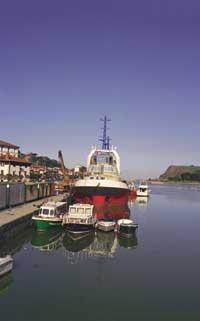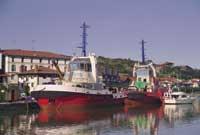Boats with three propellers from Zumaia to Germany
If you look from the outside, the two trailers just left from the Balenciaga Shipyard, whether they are experts or not, say nothing special to the viewer. In fact, their peculiarities are found in the guts and at the same time submerged, although their most remarkable feature is that they are working on water. To clarify the mystery, these new ships manufactured in Zumaia, instead of having one or two propellers as usual, have three, instead of one or two engines. "From this characteristic derives the singularity of the mentioned tugboats, that are words of the Technical Director of the Shipyard Balenciaga, José Luis Sansinenea, on the one hand for his great strength and on the other for the maneuverability of these ships".
Although Sansinenea has mentioned separately, in these ships there is a strong relationship between force and maneuverability, both derived from the work of the propellers. With three engines, these tugboats have more strength, with a total power of 6,300 horses per 2.100 hp engine. Like this number of motorcycles and propellers is not normal, the same can be said of the arrangement of the propellers and therefore of the propulsion. Normally horizontal axis propellers are used, in which the propellers that combine horizontal and vertical axis have been introduced: one in the center of the boat and the other two in the back, in the language of the sailors in the chopa. "What is achieved with this? That the propellers can make 360º. Think of the advantage of the maneuverability of the boat". Although outside the usual use of horizontal and vertical axis propellers is not something new, since 40/45 years ago they were invented in Germany. Since then, however, it is not a technique too used in shipbuilding, since the construction of a two-propeller ship is simpler and much more economical.
Heading to Germany

Although the construction of two new tugboats has been more costly than conventional tugboats, they are not a consequence of the whim, but of the clear business spirit. "Look, we make ships on demand. We are coming shipowners, they indicate what they want, we present the proposal to them and when we agree we begin to work. These two ships we have constructed for a concrete job. Both travel to Germany, in the port of Bremerhaven. There mainly travel boats of transport of cars pulled by tugboats. To pull these boats are normally necessary four tugboats, but the two manufactured by us are sufficient. It is clear that renting the service of two tugboats is cheaper than renting a room, and the shipowner who commissioned us is to offer this service: transporting most of the ships that enter the port offering a cheaper service that do the same". Therefore, what at first seemed expensive has become a business in Germany.
On the other hand, the characteristics of the ships manufactured in Zumaia are also adapted to the work of Bremerhaven. This port is of tight lock and the cargo ships that enter it, for the transport of cars, are of special characteristics: of great surface and very high. With these characteristics and taking into account that they enter the port at very low speed, when the wind hits with a little bit of force, even if it seems the opposite, it uses them easily from one side to the other, from one side to the other. The tugboats of enormous power and maneuverability can adapt perfectly to this panorama. Also small are the two tugboats of Zumaia that can work in narrow locks: 30 meters in length, from the bow to the txoña, 12 in width, from the abanto to the starboard, and 5.4 in height from the keel to the main deck, 600 tons of total weight and 300,000 tons of capacity to move the oil tanker.
Shipbuilding: work to parts
These ships that have travelled to Germany have been built by order and the rest are made by order. The process starts from the idea that the client has, which in most cases is very concrete, as indicated by José Luis Sansinenea, which fixes several details. After talking to the shipowner, the budget is fixed and although the project is in a position to begin, it is gradually defined.
Before starting the own naval construction, plans are made by parts. First, plans of form or main planes are made, fixing the general aspect of the vessel and several sections. According to these forms, the boat is traced. Currently in the shipyard Balenciaga the tracing is done by computer, but until 6 years ago it was carried out on a large wooden board placed on the floor to scale 1:1! ! News There are still places where we work like this. Once the tracing was done, the wooden models were removed, from where they were carried to the steel, they were marked and cut by hand with blowers. At present, as indicated, the layout is done by computer, the coordinates are introduced into the computer, the forms that prevent the appearance of steps are clicked on the computer, and hence all the necessary data in the cutting machines are released.
Once the planes of form and known the data that are extracted from it, it is possible to start the construction of the ship, as it has been done and is carried out habitually, by welding. It is time to start making other types of planes; structure, interior of the boat. In it is determined the consistency, profiles, number and size of the reinforcements of the necessary plate in each zone of the ship.
Below are realized plans of the elements of great importance in the ships, the circuits, because of the abundance of pipes in the ships. From there the customer can order whatever they want: oil, diesel, fresh water, salt water, runoff, straw, wind, probe, ventilation and escape. Once the circuit is determined, the schemes are made, taking into account the diameter of the tubes and the type of valves. Before having the computers it was necessary to go to the boat, see where all the circuits had to be placed, and depending on this, the wire models were moulded to then place the tubes. Currently a computer program specially prepared for shipbuilding is used.
Also you have to make plans of habilitation, such as cabins, rooms, etc. See where and how they are located. In the same way, safety plans are elaborated, especially against the fire, due to the dangerousness of the fires in the ships. For this reason special synthetic materials, of difficult combustion, are used in the present naval construction. Finally, there would be electricity plans related to generators, electrical circuits, etc. From there there are details such as carpentry, painting, etc.
The hull of any boat would be carried out following approximately the phases and plans indicated in the previous lines. That of the motor is another thing, which normally remains outside the shipyards. "The engine or the engines are the thing of the shipowner, he buys them in the companies that are doing it. In the case of these two tugboats we have added them in the central phase before finishing the hull. In addition, most of the time this is done, but there are exceptions."
Illusion of better form
The construction works of the last two ships that have been carried out in the Balenciaga Shipyard, began in January and were going to be made available to the German shipowner before the end of the year, so they have had to meet approximately one year.

In this sense, they agree in the shipyard Balenciaga, which has had a job of all the year. In view of the new year, they are optimistic, since the construction works of another boat have begun.
It seems, therefore, that little by little the red situation that the shipbuilding has lived in recent years is changing. "It seems like there are bad years, it was time, because we have spent a few very bad years. As most shipyards have closed, now the competition is smaller and for which we have remained the situation is better than before. A few years ago we were more steel boats, but today in Euskal Herria we are only five: In Bizkaia La Naval, Murueta and Zamacona, and in Gipuzkoa Pasaia and us.
On the other hand, the administration also treats us better and gives us good subsidies, from 5% to 9% of the average cost of the boat. A few years ago naval construction was considered an industry of the 3rd world, but now it seems that the way of thinking has changed and they have realized that there are many people and sectors that live around the naval construction.
On the other hand, we have to be optimistic for the future, because we are in a quality situation comparable to that of others and competitive price. Investments in shipbuilding have been important in recent times and that will bear fruit".





